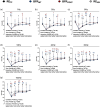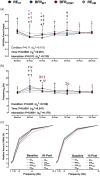The addition of blood flow restriction during resistance exercise does not increase prolonged low-frequency force depression
- PMID: 38562023
- PMCID: PMC11061635
- DOI: 10.1113/EP091753
The addition of blood flow restriction during resistance exercise does not increase prolonged low-frequency force depression
Abstract
At a given exercise intensity, blood flow restriction (BFR) reduces the volume of exercise required to impair post-exercise neuromuscular function. Compared to traditional exercise, the time course of recovery is less clear. After strenuous exercise, force output assessed with electrical muscle stimulation is impaired to a greater extent at low versus high stimulation frequencies, a condition known as prolonged low-frequency force depression (PLFFD). It is unclear if BFR increases PLFFD after exercise. This study tested if BFR during exercise increases PLFFD and slows recovery of neuromuscular function compared to regular exercise. Fifteen physically active participants performed six low-load sets of knee-extensions across four conditions: resistance exercise to task failure (RETF), resistance exercise to task failure with BFR applied continuously (BFRCONT) or intermittently (BFRINT), and resistance exercise matched to the lowest exercise volume condition (REVM). Maximal voluntary contraction (MVC) force output, voluntary activation and a force-frequency (1-100 Hz) curve were measured before and 0, 1, 2, 3, 4 and 24 h after exercise. Exercise to task failure caused similar reductions at 0 h for voluntary activation (RETF = 81.0 ± 14.2%, BFRINT = 80.9 ± 12.4% and BFRCONT = 78.6 ± 10.7%) and MVC force output (RETF = 482 ± 168 N, BFRINT = 432 ± 174 N, and BFRCONT = 443 ± 196 N), which recovered to baseline values between 4 and 24 h. PLFFD occurred only after RETF at 1 h supported by a higher frequency to evoke 50% of the force production at 100 Hz (1 h: 17.5 ± 4.4 vs. baseline: 15 ± 4.1 Hz, P = 0.0023), BFRINT (15.5 ± 4.0 Hz; P = 0.03), and REVM (14.9 ± 3.1 Hz; P = 0.002), with a trend versus BFRCONT (15.7 ± 3.5 Hz; P = 0.063). These findings indicate that, in physically active individuals, using BFR during exercise does not impair the recovery of neuromuscular function by 24 h post-exercise.
Keywords: PLFFD; ischaemia; oxygen availability; volitional fatigue.
© 2024 The Authors. Experimental Physiology published by John Wiley & Sons Ltd on behalf of The Physiological Society.
Conflict of interest statement
The authors declare no conflicts of interest.
Figures





References
-
- Adami, A. , & Rossiter, H. B. (2018). Principles, insights, and potential pitfalls of the noninvasive determination of muscle oxidative capacity by near‐infrared spectroscopy. Journal of Applied Physiology, 124(1), 245–248. - PubMed
-
- Allen, D. G. , Lamb, G. D. , & Westerblad, H. (2008). Skeletal muscle fatigue: Cellular mechanisms. Physiological Reviews, 88(1), 287–332. - PubMed
-
- Andrade, F. H. , Reid, M. B. , & Westerblad, H. (2001). Contractile response of skeletal muscle to low peroxide concentrations: Myofibrillar calcium sensitivity as a likely target for redox‐modulation. Federation of American Societies of Experimental Biology Journal, 15(2), 309–311. - PubMed
-
- Barstow, T. J. (2019). Understanding near infrared spectroscopy and its application to skeletal muscle research. Journal of Applied Physiology, 126(5), 1360–1376. - PubMed
-
- Broxterman, R. M. , Ade, C. J. , Craig, J. C. , Wilcox, S. L. , Schlup, S. J. , & Barstow, T. J. (2015). Influence of blood flow occlusion on muscle oxygenation characteristics and the parameters of the power‐duration relationship. Journal of Applied Physiology, 118(7), 880–889. - PubMed
Publication types
MeSH terms
Grants and funding
LinkOut - more resources
Full Text Sources
Medical
Miscellaneous
